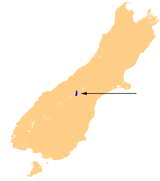Lake Pukaki
| Lake Pukaki | |
|---|---|
 September 2005 | |
| Location | Mackenzie District, Canterbury Region, South Island |
| Coordinates | 44°07′S 170°10′E / 44.117°S 170.167°ECoordinates: 44°07′S 170°10′E / 44.117°S 170.167°E |
| Primary inflows | Tasman River |
| Primary outflows | Pukaki River |
| Catchment area | 1,413 km² [1] |
| Basin countries | New Zealand |
| Surface area | 178.7 km² [1] |
| Average depth | 47 m [1] |
| Max. depth | 70 m [1] |
| Water volume | 4.66 km³ [1] |
| Surface elevation | 518.2 to 532 m [2] |
| Islands | Five Pound Note Island (now submerged) |
| Settlements | Mount Cook Village |
| References | [1][2] |
Lake Pukaki is the largest of three roughly parallel alpine lakes running north-south along the northern edge of the Mackenzie Basin on New Zealand's South Island. The others are Lakes Tekapo and Ohau. All three lakes were created when the terminal moraines of receding glaciers blocked their respective valleys, forming moraine-dammed lakes.
The glacial feed to the lakes gives them a distinctive blue colour, created by glacial flour, the extremely finely ground rock particles from the glaciers. Lake Pukaki covers an area of 178.7 km², and the surface elevation of the lake normally ranges from 518.2 to 532 metres above sea level.[2]


The lake is fed at its northern end by the braided Tasman River, which has its source in the Tasman and Hooker Glaciers, close to Aoraki/Mount Cook. Good views of the mountain, 70 kilometres to the north, can be had from the southern shore of the lake.
The lake is now part of the Waitaki hydroelectric scheme. The lake's original outflow was at its southern end, into the Pukaki River. The outflow has been dammed, and canals carry water from Lake Pukaki and Lake Ohau through the Ohau A power station to Lake Ruataniwha. Pukaki is also fed by the waters of Lake Tekapo, which are diverted through a canal to a power station on Pukaki's eastern shore (Tekapo B station). The lake has been raised twice to increase storage capacity (9m in the 1940s, 37m in the 1970s), submerging Five Pound Note Island, which once appeared on New Zealand's five pound note. The current lake has an operating range of 13.8 m (the level within which it can be artificially raised or lowered), giving it an energy storage capacity of 1,595 GWh. Along with Lake Tekapo's 770 GWh storage, it provides over half New Zealand's hydroelectricity storage capacity. In September 2012, Environment Canterbury approved a change in conditions of Meridian Energy's resource consent controlling the water levels and flows of Lake Pukaki. The change allows Meridian to lower the lake a further five metres from the minimum level of 518m above sea level in the event of an energy crisis. [3]
Gallery
-

November 2009
References
- ↑ 1.0 1.1 1.2 1.3 1.4 1.5 Irwin, J. (September 1978). "Bottom sediments of Lake Tekapo compared with adjacent Lakes Pukaki and Ohau, South Island, New Zealand" (PDF). N.Z. Journal of Marine and Freshwater Research 12 (3). pp. 245–250. Retrieved 2007-11-09
- ↑ 2.0 2.1 2.2 "Pukaki Lake Levels". Meridian Energy Limited. Retrieved 2008-03-09.
- ↑ Lttlewood, Matthew (28 September 2012). "Meridian get freedom to lower lake Stuff.co.nz". The Timaru Herald. Retrieved 29 September 2012.
Further reading
- J. Irwin, Sediments of Lake Pukakaki, South Island, New Zealand PDF 1971
External links
- Department of Conservation – recreational opportunities
| ||||||||